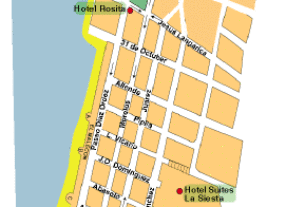In a curious irony of history, an epigone frequently becomes better known than his/her illustrious namesake and predecessor. Mention Harold Ickes and most people will think you’re talking about Clinton’s recent adviser rather than about his father, the “Old Curmudgeon,” who was one of FDR’s most dynamic cabinet members. For the sports-minded, the nickname “Sugar Ray” will be mean Leonard rather than Robinson — the difference between a very good champion and one who may have been the greatest pound-for-pound boxer ever to lace on a glove.
This irony also applies to Aztec emperors. Moctezuma II, who achieved the dubious posthumous honor of having a beer named after him, will ever be remembered as the tragic figure whose belief that white-skinned invaders may have been gods rather than men led to the fall of his mighty empire. Far less known is the namesake who played such an important part in building that empire and extending its power. To distinguish the pair by other than Roman numerals, the greater but lesser-known ruler was Moctezuma Ilhuicamina while his ill-fated successor was Moctezuma Xocoyotzin. The first surname means “lone who shoots an arrow into the sky” and the second simply means “the youngest.”
By way of a brief chronology, the Aztecs reached the Valley of Mexico in A.D. 1325. At the time, they had never shown any signs of military power. Their trek to central Mexico from the north began In A.D. 1168. A small, landless tribe, they came out of the northwest and made their way mainly by stealth, sneaking south and generally avoiding combat as they found their way impeded by other tribes. By 1325 they had established themselves on two small islets in Lake Texcoco and built a city-state called Tenochtitlan. But it wasn’t until the next century that the Aztecs (or Tenocha, as they called themselves) truly got into the empire building business.
Moctezuma (sometimes also rendered as Montezuma and Motecuhzoma) means “a lord who shows anger” so Moctezuma Ilhuicamina would come out as “a lord who shows anger and shoots an arrow into the sky.” The son of a noble named Huitzilihuitl, the exact date of his birth is unknown but it is established that he ruled between 1440-69.
Just as Moctezuma I was overshadowed after his death by a less vigorous successor, so was he eclipsed in his lifetime by his friend and ally, Nezahualcoyotl, the brilliant ruler of Texcoco. Since Nezahualcoyotl gained enduring fame as a philosopher-king in the tradition of Frederick the Great, historians tend to overlook the achievements of Moctezuma.
But this reflects more on chroniclers who should have given Moctezuma his just due than it does on Moctezuma. The Aztec ruler was a combined statesman, warrior, builder and inspired city planner. He displayed his statesmanship by forming a triple alliance with Nezahualcoyotl and the sovereign of the small kingdom of Tlacopan. William H. Prescott, the distinguished 19th American century historian, described the alliance as “that remarkable league, which … has no parallel in history.” What so impressed Prescott was that “during a century of uninterrupted warfare that ensued, no instance occurs where the parties quarreled over the division of the spoil, which so often makes shipwreck of similar confederacies among civilized states.” With this skillfully crafted Triple Alliance, Moctezuma played a major role in transforming what had been a small tribal Meso-American state into a vast empire. Whenever a new territory was conquered, one-fifth would go to the smaller state of Tlacopan with the remaining four-fifths divided between the Texcocans and the Aztecs.
But Moctezuma didn’t limit himself simply to conquest. With the aid of his ally Nezahualcoyotl, he introduced a sophisticated water supply system by building a double aqueduct that was the envy of the world. Streets were hosed down daily and the Aztecs, who bathed regularly, would come to consider the “civilized” Europeans to be as dirty as pigs. Moctezuma’s subjects also practiced a form of ecology by collecting excreta for fertilizer and keeping it out of rivers and lakes.
Moctezuma’s reign was one of unequaled prosperity. The Aztec economy was a blend of socialism and free market capitalism. Though land was owned by the state, citizens enjoyed the usufruct of their labor and the Spaniards were astounded by the opulence of Tenochtitlan’s markets.
It was under Moctezuma I that the pax Azteca reached its highest level. Victor von Hagen, author of a widely acclaimed work on the Aztecs, described their empire as a “tribute state,” meaning that their goals were purely economic and that they made no attempt to impose their culture of religion on subject peoples. While the calpixque (tax collectors) were greatly disliked (who ever heard of a popular tax collector?), many conquered peoples willingly accepted Aztec rule because it freed them from petty tribal struggles and made the roads traveled by their merchants safe from attack. These merchants found an ideal market in the capital of Tenochtitlan, larger than any city in Europe.
A special type of Aztec merchant who flourished under Moctezuma I was the celebrated pochteca. An argument might be made that to call a pochteca a mere merchant is like calling Bill Gates a software salesman. These powerful men, who traveled as far north as Texas and as far south as Nicaragua, combined the role of intelligence agent and commercial traveler. Functioning as an Aztec CIA, the pochteca were so respected that they were exempted from trial by ordinary tribunals. Attacks against pochtecas brought severe retaliation and when a pochteca died in a foreign land he was buried with the honors equal to those of a warrior slain in combat.
Moctezuma llhuicamina died almost exactly a half century before Hernan Cortés and his men made their Good Friday landing on the domains of his vacillating namesake. Had this resolute warrior been at the helm on that fateful day, history might well have recorded a different kind of Conquest — that of the vastly outnumbered Spaniards by hordes of Aztec defenders.

